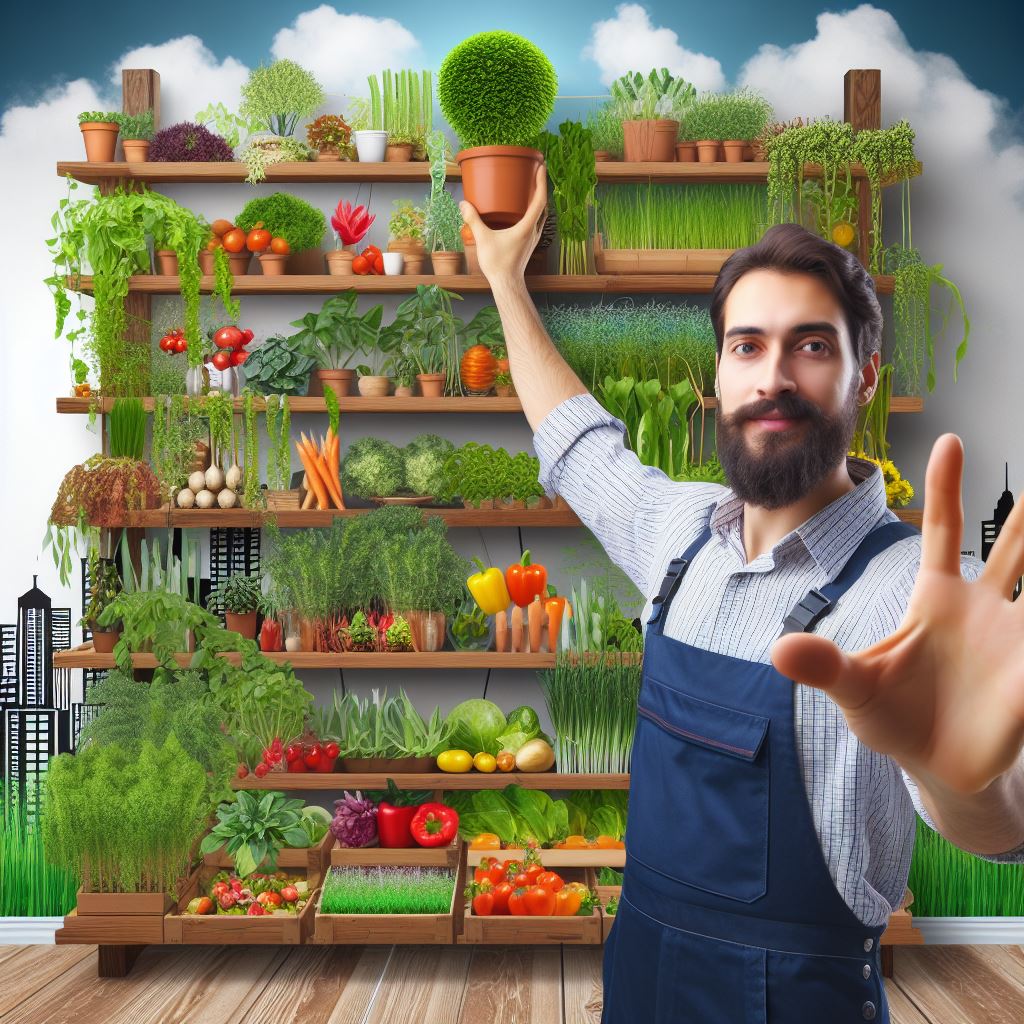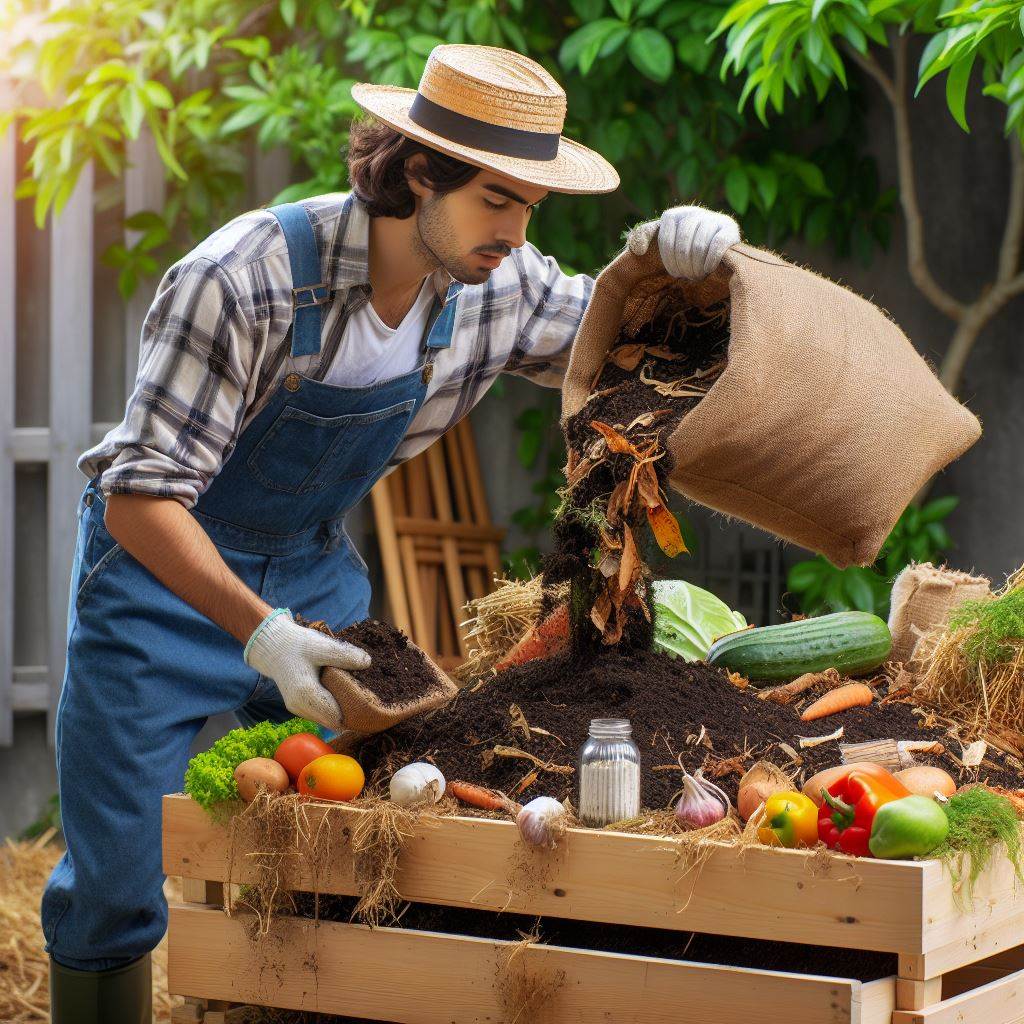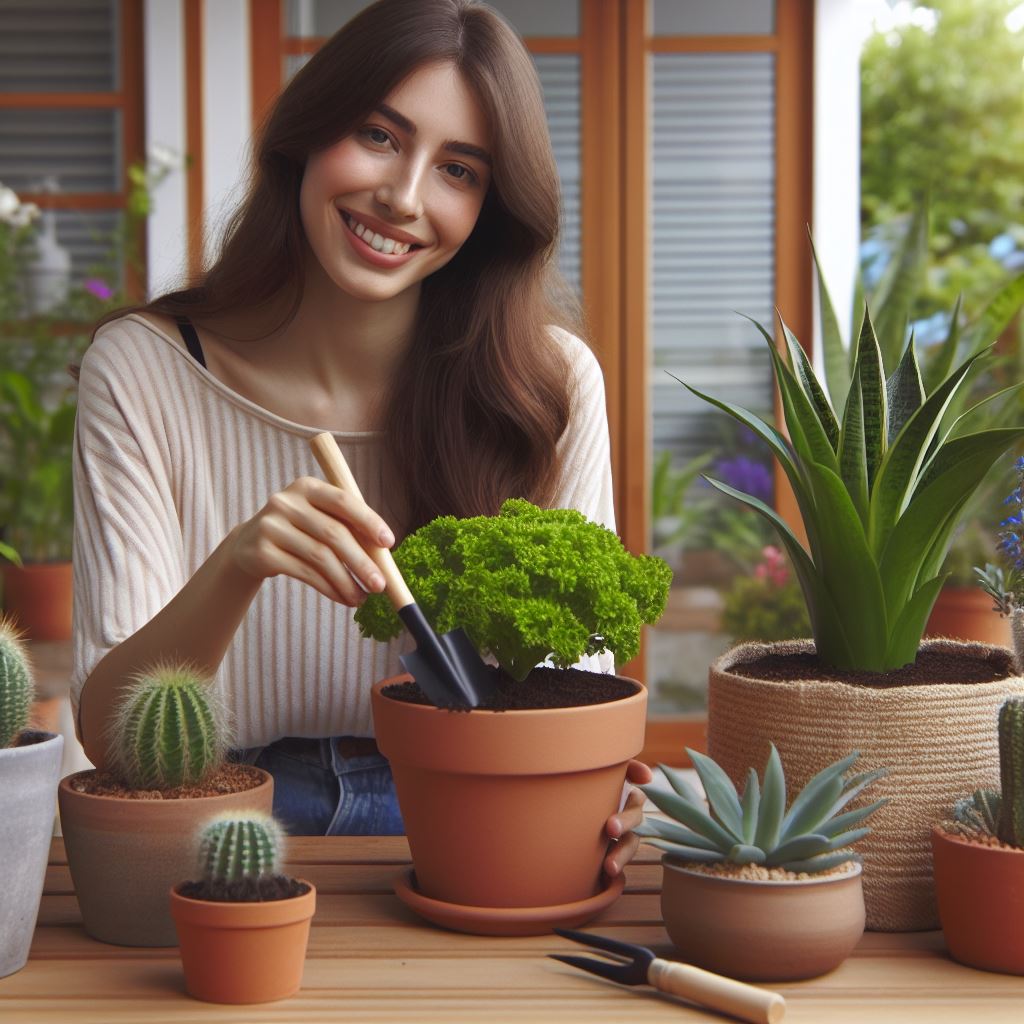Introduction
Vertical gardening is an innovative technique that allows plants to grow upward instead of outward.
This method has gained tremendous popularity in recent years, thanks to its numerous benefits.
Let’s explore this remarkable gardening technique in more detail and understand why it is becoming increasingly popular.
Benefits of Vertical Gardening
Vertical gardening offers several advantages for gardeners.
Firstly, it maximizes the use of limited space, making it ideal for urban environments.
It allows individuals to grow plants in small balconies, patios, or even indoors.
Additionally, it reduces the need for extensive bending, making it a feasible option for people with physical limitations.
Furthermore, vertical gardening provides better air circulation around plants, leading to healthier growth.
It also minimizes the risk of soil-borne diseases and pests since the plants are elevated off the ground.
Growing Popularity
As more individuals recognize the benefits of vertical gardening, its popularity has skyrocketed.
People are increasingly drawn to this technique as it enables them to have a green space in the concrete jungles of cities.
Moreover, vertical gardens enhance the aesthetic appeal of homes and public spaces, serving as living artworks.
Transition to Main Points
Now, let’s delve into three key aspects of vertical gardening that will be discussed in this blog post.
We will explore the different types of vertical gardening structures, the best plant choices for vertical gardens, and essential tips for successfully maintaining a vertical garden.
By exploring these topics, we aim to provide you with valuable insights and guidance to embark on your own vertical gardening journey.
Transform Your Agribusiness
Unlock your farm's potential with expert advice tailored to your needs. Get actionable steps that drive real results.
Get StartedWhether you are an experienced gardener or a beginner, vertical gardening has something exciting to offer everyone.
What is Vertical Gardening?
Vertical gardening is a technique that involves growing plants vertically instead of horizontally.
It is a popular method among urban dwellers or those with limited space.
With vertical gardening, plants are grown in containers or on structures that are installed vertically, such as trellises, wall-mounted planters, or vertical hydroponics systems.
This allows plants to grow upward, making efficient use of the available space.
Definition and explanation of vertical gardening.
One of the main advantages of vertical gardening is its space-saving nature.
Traditional gardening requires a significant amount of space, as plants spread horizontally on the ground.
But with vertical gardening, you can grow more plants in a limited area.
By utilizing vertical space, you can transform a small balcony or even a wall into a thriving garden.
Types of vertical gardening systems (trellises, wall-mounted planters, vertical hydroponics, etc.).
Vertical gardening offers several different systems that can be used to grow plants.
Trellises are commonly used to support climbing plants such as tomatoes or beans.
These structures allow the plants to grow vertically while providing support for their stems.
Wall-mounted planters are another option and can be attached to fences or walls.
They are ideal for growing flowers or herbs and can add aesthetic appeal to any space.
Vertical hydroponics is a system that allows plants to be grown without soil.
Instead, the plants are suspended in a nutrient-rich water solution.
This method is particularly useful for those who have limited access to soil or want to grow plants indoors.
It is a space-efficient and water-saving technique.
Comparison with traditional gardening methods.
Vertical gardening also has several advantages over traditional gardening methods.
First, it reduces the need for bending and kneeling, making it a suitable option for those with physical limitations.
Additionally, vertical gardening minimizes the risk of pests and diseases, as plants are lifted off the ground where many pests reside. This can lead to healthier plants and better harvests.
In addition to these benefits, vertical gardening allows for better air circulation and sunlight exposure.
Plants grown vertically receive ample sunlight from different angles, optimizing their growth and productivity.
The increased air circulation also helps prevent the buildup of moisture, reducing the risk of fungal diseases.
Showcase Your Farming Business
Publish your professional farming services profile on our blog for a one-time fee of $200 and reach a dedicated audience of farmers and agribusiness owners.
Publish Your ProfileAnother advantage of vertical gardening is its aesthetic appeal.
Vertical gardens can serve as decorative elements, enhancing the overall look of a space.
They can transform bare walls into vibrant displays of greenery and color.
Vertical gardening also provides an opportunity to create unique designs and arrangements, making it a form of creative expression.
Therefore, vertical gardening offers numerous advantages over traditional gardening methods.
It maximizes space utilization, reduces physical strain, minimizes pest and disease risks, and provides better air circulation and sunlight exposure.
Whether you have a small balcony, limited yard space, or simply want to add greenery to your walls, vertical gardening is a practical and visually appealing solution.
Read: Organic Gardening: Grow More in Less Space
Benefits of Vertical Gardening
Vertical gardening is a popular and efficient method of growing plants in limited spaces.
By utilizing vertical structures, such as walls, trellises, and containers, gardeners can optimize their available space and grow plants vertically instead of horizontally.
This approach offers several benefits, including:
Utilization of small spaces and ability to grow vertically instead of horizontally
Vertical gardening allows individuals with limited outdoor space, such as urban dwellers, to still enjoy the benefits of gardening.
By utilizing walls, balconies, or even indoor spaces, gardeners can make the most of their available square footage and create a flourishing garden.
Maximization of sunlight exposure and air circulation
Vertical gardening ensures that plants get maximum exposure to sunlight, which is crucial for photosynthesis and plant growth.
Since plants are grown vertically, they are less likely to overshadow each other and hinder sunlight absorption.
Additionally, proper spacing between plants in a vertical garden improves air circulation, reducing the likelihood of fungal diseases.
Reduction of weed growth and pest problems
Vertical gardening minimizes weed growth as the close proximity of plants shades the soil and prevents weed seeds from germinating.
Furthermore, the elevation of plants makes it more difficult for pests to access them.
This reduces the need for chemical pesticides, making vertical gardening a more eco-friendly option.
Easier maintenance and harvesting
Vertical gardens are easily accessible, making maintenance tasks such as watering, pruning, and fertilizing much simpler compared to traditional gardens.
Gardeners can save time and effort by tending to their plants at a comfortable height, without the need for excessive bending or kneeling.
Harvesting is also more convenient, as plants can be easily reached and harvested without damaging other plants.
Potential for increased yield and variety of crops
Vertical gardening provides the opportunity to grow a wide variety of plants in a small area.
This allows gardeners to diversify their harvest and experiment with different crops.
By utilizing vertical space effectively, gardeners can increase their overall yield and enjoy a greater variety of homegrown produce.
Most importantly, vertical gardening offers numerous benefits that make it an attractive option for gardeners with limited space.
The utilization of small spaces, maximization of sunlight exposure, reduction of weed growth and pest problems, easier maintenance and harvesting, and the potential for increased yield and variety of crops make vertical gardening a practical and rewarding gardening method.
Whether you live in an urban apartment or have a small backyard, vertical gardening allows you to embrace your green thumb and enjoy the joys of gardening.
Read: DIY Compost Bins: Cheap and Effective Designs

Setting up a Vertical Garden
When it comes to vertical gardening, there are several important steps to consider.
From selecting the right plants to preparing the soil, each step plays a crucial role in the success of your garden.
Here’s a step-by-step guide to help you set up your own vertical garden:
Choosing the location and assessing available space and sunlight
Start by examining your space and identifying the best spot for your vertical garden.
Look for an area that receives sufficient sunlight throughout the day.
Keep in mind that different plants have varying requirements, so choose a location that suits your chosen plants.
Selecting suitable plants for vertical gardening
Take the time to research and select plants that thrive in vertical gardening environments.
Vines, herbs, flowers, and vegetables are popular choices for vertical gardens.
Consider the climate, available space, and personal preference when making your selections.
Selecting the appropriate vertical gardening system based on your needs
There are various vertical gardening systems available, such as trellises, stacked planters, wall-mounted pockets, and modular systems.
Choose a system that suits your needs, available space, and desired aesthetics. Consider factors like ease of installation, maintenance, and water drainage.
Showcase Your Farming Business
Publish your professional farming services profile on our blog for a one-time fee of $200 and reach a dedicated audience of farmers and agribusiness owners.
Publish Your ProfilePreparing the soil or opting for hydroponic systems
Depending on your preference, you can either prepare the soil or opt for hydroponic systems.
If you choose to grow plants in soil, ensure it’s well-draining, nutrient-rich, and suitable for your selected plants.
Hydroponic systems, on the other hand, provide plants with direct nutrients and water.
Implementation of irrigation and nutrient delivery systems
Watering and feeding your vertical garden are crucial for its health and productivity.
Install an efficient irrigation system that ensures each plant receives adequate moisture.
Consider using drip irrigation or a self-watering system.
Additionally, incorporate a nutrient delivery system to provide essential plant nutrients.
By following these steps, you can successfully set up a vertical garden that not only maximizes your available space but also adds a touch of greenery to your surroundings.
Remember to regularly maintain your garden by pruning, monitoring for pests, and providing the necessary care for your chosen plants.
Read: Soil Health Secrets: Tips for Nutrient-Rich Soil
You Might Also Like: Climate Zones: Planting for Your Area
Vertical Gardening Tips
Proper Spacing and Training of Plants to Grow Up Supports
One of the key aspects of successful vertical gardening is ensuring proper spacing and training of plants.
Since the plants grow upwards, it is essential to provide them with adequate support structures.
By maintaining the right distance between plants, you allow them to receive sufficient sunlight and air circulation, which promotes healthy growth.
Additionally, training plants to climb on support structures helps optimize space utilization.
Regular Monitoring of Plant Growth and Adjustment of Support Structures
Vertical gardens require continuous monitoring to ensure plants are growing properly and adapting to their support structures.
Regularly check for any signs of growth abnormalities, such as wilting or crowding.
Adjust the support structures as needed to accommodate the plants’ height and size.
By doing so, you provide stability and encourage upward growth, preventing plants from leaning or falling over.
Proper Watering Techniques, Considering the Vertical Arrangement
Watering vertical gardens can be a bit different from traditional gardens.
As gravity affects water distribution, it is crucial to apply proper watering techniques.
Consider using drip irrigation systems or attaching irrigation tubes to the support structures.
This ensures even water distribution throughout the garden, reaching each plant effectively.
Avoid overwatering as excessive moisture can lead to root rot and other plant diseases.
Timely Pruning, Fertilizing, and Pest Control
Just like any other garden, vertical gardens also require regular maintenance activities such as pruning, fertilizing, and pest control.
Pruning helps maintain the shape and size of plants while encouraging new growth.
Fertilizing supplies essential nutrients to the plants, promoting their health and vigor.
To prevent pest infestation, regularly inspect the plants for any signs of insects or diseases and promptly take appropriate measures.
Exploring Creative Ideas for Vertical Gardening, such as Repurposing Materials
Vertical gardening offers endless opportunities for creativity and innovation.
You can explore various ideas to make your vertical garden unique and visually appealing.
Consider repurposing materials like pallets, ladders, or old gutters to create vertical planters.
Utilize hanging baskets or trellises for sprawling plants.
Arrange plants in patterns or mix different varieties to add visual interest.
The possibilities are limitless, so let your imagination run wild!
Incorporating these tips into your vertical gardening approach will help you create a flourishing and space-efficient green oasis.
With proper spacing and plant training, regular monitoring, appropriate watering techniques, timely maintenance, and creative ideas, you can unlock the full potential of vertical gardening.
Enjoy the beauty and functionality of this innovative gardening method, and revel in the joy of cultivating your own lush vertical paradise.
Read: Worm Composting: Turning Waste into Gold
Success Stories and Examples
Vertical gardening has gained popularity worldwide as individuals and communities embrace this innovative approach to overcome limited space and environmental challenges.
Let’s explore some success stories and inspiring examples that showcase the potential and beauty of vertical gardening.
Showcase Your Farming Business
Publish your professional farming services profile on our blog for a one-time fee of $200 and reach a dedicated audience of farmers and agribusiness owners.
Publish Your ProfileShowcasing Successful Vertical Gardening Projects
- The Bosco Verticale, Milan, Italy: One of the most famous vertical gardening projects, this residential tower boasts over 900 trees, 5,000 shrubs, and 11,000 plants, creating a stunning green facade.
- Urban Food Forest, New York City, USA: This community project transformed a vacant lot into a lush vertical garden, providing fresh produce to local residents and educating them about sustainable agriculture.
- One Central Park, Sydney, Australia: Standing tall at 166 meters, this luxurious residential complex incorporates vertical gardens on its facades, creating a beautiful and green living environment.
- The Green Acres Mall, New York City, USA: With the aim of promoting sustainable living, this shopping center implemented a vertical garden installation that not only enhances the aesthetics but also improves air quality.
Inspiring Stories of Overcoming Space and Environmental Challenges
- Vertical Farming in Singapore: As one of the most densely populated cities, Singapore faces limited space for traditional agriculture. Vertical farms have emerged, using advanced hydroponic systems to grow a variety of crops efficiently.
- Rooftop Gardens in Mumbai, India: In a city where open green spaces are scarce, many individuals and communities have transformed rooftops into flourishing gardens, fostering a sense of community and providing a sanctuary in the urban jungle.
- Urban Community Gardens in Tokyo, Japan: With limited land available, Tokyo residents have embraced vertical gardening as a way to produce their own food in small spaces, creating sustainable and self-sufficient communities.
- Vertical Gardens in Desert Regions: In arid regions like Dubai and Las Vegas, vertical gardens have been utilized to combat the harsh desert environment. These gardens not only add beauty to the surroundings but also help cool the buildings through evaporative cooling.
Visual Examples of Aesthetically Pleasing and Productive Vertical Gardens
- Green Walls: Many buildings across the world have installed vertical gardens on their walls, transforming dull concrete facades into vibrant, living artworks.
- Living Tunnels: Some cities have implemented vertical gardens on walkways and tunnels, creating a refreshing and natural atmosphere for pedestrians and cyclists.
- Vertical Hydroponic Systems: These indoor systems use vertical structures to grow vegetables and herbs without soil, ensuring a year-round supply of fresh produce in urban areas.
- Greening Balconies and Terraces: Individuals living in apartments and high-rise buildings have embraced vertical gardening by transforming their balconies and terraces into green oases, adding beauty and improving air quality.
In short, vertical gardening has provided innovative solutions to overcome limited space and environmental challenges.
With success stories from around the world and visually inspiring examples, this gardening technique has proven to be both aesthetically pleasing and productive.
Whether in residential towers, community projects, or individual spaces, vertical gardens offer a sustainable way to enhance our urban environments and reconnect with nature.
Conclusion
Vertical gardening offers numerous benefits and advantages.
It maximizes space, reduces the need for bending and kneeling, and prevents soil erosion.
Vertical gardens also improve air quality, add beauty to urban spaces, and provide fresh produce.
Considering all these advantages, it is clear that integrating vertical gardening into our lives is a great idea.
Whether we have a small balcony or limited backyard space, we can still enjoy the benefits of growing our own food and creating a green oasis.
To get started with vertical gardening, there are many resources available.
Online tutorials, books, and local gardening groups can provide useful information and inspiration.
Additionally, reaching out to experienced vertical gardeners or sharing our own experiences can foster a supportive community.
So why wait? Let’s take the first step towards vertical gardening and start enjoying its many benefits.
Whether we want to grow herbs, flowers, or vegetables, there is a vertical gardening solution that will suit our needs.
By embracing vertical gardening, we not only improve our own lives but also contribute to a more sustainable and greener planet.
So, let’s get our hands dirty, plant some seeds, and watch our gardens flourish.
Don’t hesitate to share your experiences, ask questions, and connect with fellow vertical garden enthusiasts.
Together, we can create a thriving vertical gardening community and reap the rewards of this innovative approach to gardening.




